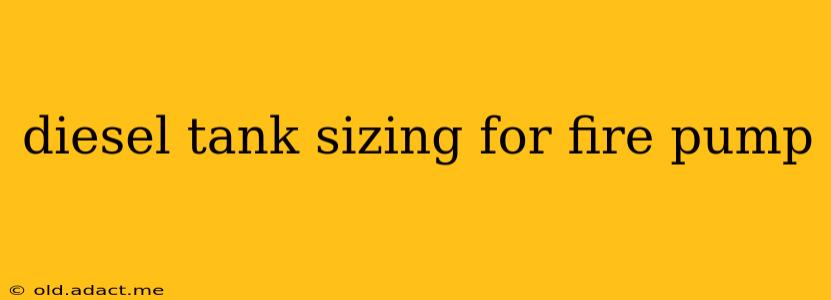Ensuring adequate fire protection is paramount for any facility. A crucial component of this system is the fire pump, and its reliable operation depends heavily on the size and capacity of its associated diesel fuel tank. Incorrect sizing can lead to system failure during a critical event, jeopardizing lives and property. This guide provides a comprehensive overview of diesel tank sizing for fire pumps, addressing common questions and considerations.
What factors determine diesel tank size for a fire pump?
The appropriate size of a diesel fuel tank for a fire pump isn't a one-size-fits-all answer. Several critical factors influence the necessary capacity:
- Pump Capacity and Run Time: This is the most significant factor. The larger the pump and the longer it needs to run, the more fuel it will consume. Fire codes and insurance requirements often dictate minimum run times (e.g., 30 minutes, 1 hour, or even longer). Accurate calculation of fuel consumption based on pump flow rate, pressure, and efficiency is crucial.
- Fuel Consumption Rate: Determining the pump's fuel consumption rate requires knowing its specific fuel consumption per hour (usually provided in the pump's specifications). This rate multiplied by the required run time directly translates to the total fuel needed.
- Redundancy and Reserve Capacity: It's essential to incorporate a safety margin. A typical recommendation is to include at least a 20-30% reserve capacity beyond the calculated minimum to account for unforeseen circumstances or potential pump inefficiencies. This reserve ensures uninterrupted operation even if fuel consumption exceeds initial estimations.
- Accessibility and Location: The physical location and accessibility of the tank influence its size and design. Limited space might necessitate a smaller, more compact tank, while ease of access for refueling is crucial for practical maintenance.
- Local Codes and Regulations: Always adhere to local fire codes, building codes, and insurance requirements regarding tank size, location, and safety features. These regulations often specify minimum capacities and safety standards.
- Type of Diesel Fuel: The type of diesel fuel used can slightly affect consumption rates. While the difference isn't dramatic, it's worth considering for extremely precise calculations.
How is the fuel consumption rate of a fire pump determined?
The fuel consumption rate is typically expressed in gallons per hour (GPH) or liters per hour (LPH). This information is usually found in the fire pump's technical specifications provided by the manufacturer. If not directly available, you can consult the pump's performance curve, which usually shows fuel consumption at different operating points. If neither is available, consult a qualified pump specialist or engineer.
What are the safety considerations for diesel tank sizing?
Safety is paramount. Several considerations are vital:
- Tank Material and Construction: Choose a tank made of robust, corrosion-resistant material appropriate for diesel fuel storage. Consider double-walled tanks for added safety.
- Overfill Protection: Implement an overfill prevention system to avoid accidental spills and environmental hazards.
- Leak Detection: Regularly inspect the tank for leaks. Consider incorporating leak detection systems for early warning.
- Ventilation: Adequate ventilation is crucial to prevent the buildup of flammable vapors.
- Grounding and Bonding: Proper grounding and bonding are essential to prevent static electricity buildup, which could cause a fire hazard.
- Location: Position the tank away from ignition sources and in a well-ventilated area.
What are the common sizes of diesel tanks for fire pumps?
Diesel tank sizes for fire pumps vary significantly depending on the factors discussed above. There's no standard size. Tanks range from relatively small units for smaller pumps with short run times to much larger tanks for high-capacity pumps requiring extended operation.
How do I calculate the required tank size for my fire pump?
Calculating the precise tank size requires a thorough understanding of the pump's specifications and operational requirements. It’s best to consult with a qualified fire protection engineer or a specialist in fire pump systems. They can perform accurate calculations and ensure compliance with all applicable codes and regulations.
This guide provides a foundational understanding of diesel tank sizing for fire pumps. Remember that proper sizing is crucial for reliable fire protection. Always consult with qualified professionals to ensure the safety and efficacy of your system. Ignoring these crucial considerations can have serious consequences.
